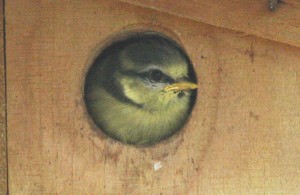 Now is the time to look at the birds’ nestboxes in the garden and plan for the year ahead so that there is plenty of time to refurbish boxes, put up new ones or replace others. One of the problems is that there are so many different types of nestboxes that it can be confusing. The last time I looked at nestboxes in a garden centre they were mainly what was called standard boxes for small birds such as great tits and blue tits. Then there were owl boxes, mainly of a design aimed at tawny owls, and even, in one garden centre, a box for kestrels. One garden centre has the small standard boxes but they had such a tiny entrance hole I doubt whether even the smallest of birds, the blue tits, would manage to squeeze into the box. Most garden centres sell ideal nestboxes but another way is to look at the variety of nestboxes available and then go away and make them yourself. The alternative, if you are not inclined to woodwork, is to get someone to make one for you either from their design or a design you provide. There are plenty of people who would do this.
Now is the time to look at the birds’ nestboxes in the garden and plan for the year ahead so that there is plenty of time to refurbish boxes, put up new ones or replace others. One of the problems is that there are so many different types of nestboxes that it can be confusing. The last time I looked at nestboxes in a garden centre they were mainly what was called standard boxes for small birds such as great tits and blue tits. Then there were owl boxes, mainly of a design aimed at tawny owls, and even, in one garden centre, a box for kestrels. One garden centre has the small standard boxes but they had such a tiny entrance hole I doubt whether even the smallest of birds, the blue tits, would manage to squeeze into the box. Most garden centres sell ideal nestboxes but another way is to look at the variety of nestboxes available and then go away and make them yourself. The alternative, if you are not inclined to woodwork, is to get someone to make one for you either from their design or a design you provide. There are plenty of people who would do this.
Whichever way you follow, buying one, making your own or getting someone else to make it, the best way, by far, is to refer to that “Bible” of nestboxes, the booklet published by the British Trust for Ornithology. This was first published in 2003 and written by Chris du Feu entitled “The BTO Nestbox Guide” and the last time I spoke to the BTO it was still for sale. For further details telephone the BTO on 01842 750050. It goes into all the different designs and even some special requirements such as the birds that need the nestbox filled with chippings to form the hole themselves. It covers them all from swallow nestboxes to those for barn owls, sand martins and even the specialised tree creeper. Over the years, in my garden, I have out up nestboxes for kestrels, owls, mandarin ducks, robins, swallows, house martins and tree creepers. Some, I must admit, with for some reason, no success.
One recent innovation has given bird garden enthusiasts the chance to have a close look at what is happening in their nestboxes. Tiny cameras inside the nestboxes can be linked to computers or T.V.s and you can watch the proceedings live. These cameras are constantly going down in price and at present you can get them, with all the cables and fittings, for just over £100. Some garden centres stock them and the BTO sell them so it is worth considering for the coming summer. I tried one last year and sat in my study watching proceedings on my computer as the breeding secrets of a pair of blue tits unfolded in front of me. Just after the final egg was laid both adults were taken by a sparrowhawk just outside my window! It will be interesting to see what happens next summer as I have moved the nestbox.
As for inspecting nestboxes, then unless you are taking part in a special survey I think it is best to leave nestboxes alone. You can see what birds are using the nestbox by watching from a distance so as not to disturb the birds. They have enough problems gathering food and feeding young without being disturbed. If you are lucky you may see the young begging for food at the nestbox entrance such as the young blue tit in a nestbox in my garden.
Tags: highland wildlife
